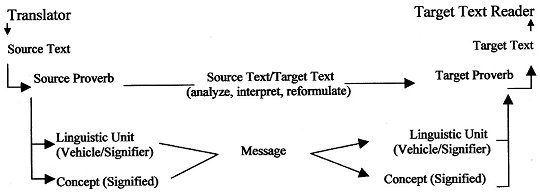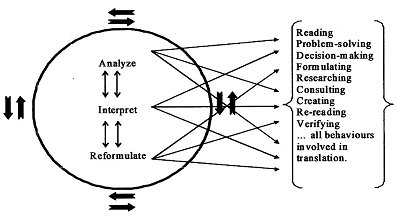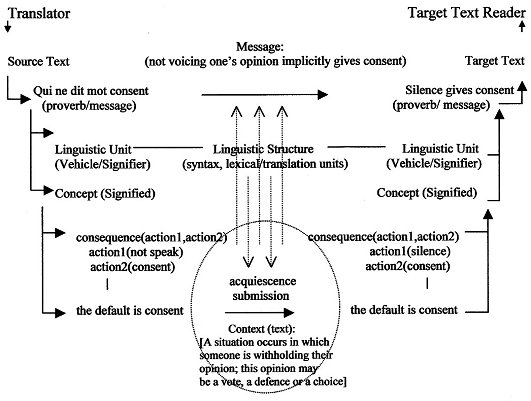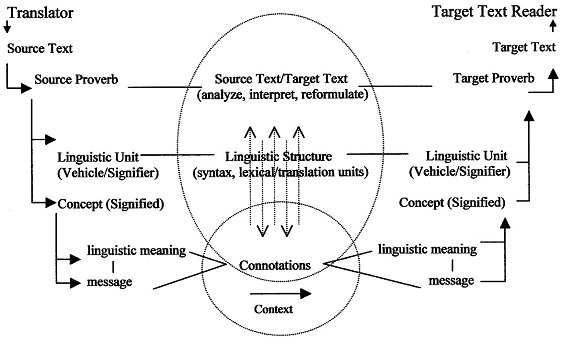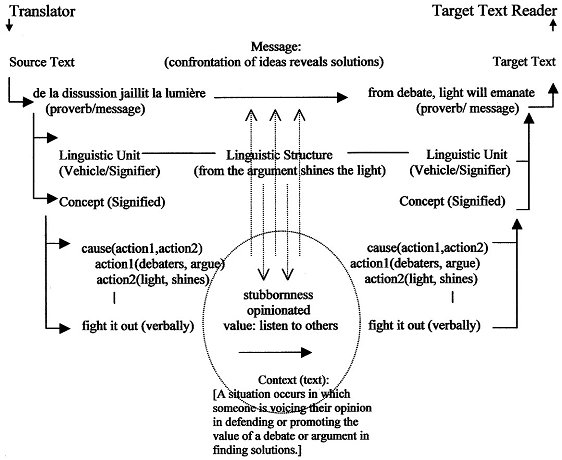|
Front Page
|
| |
|
|
A Model of Translation Based on Proverbs and Their Metaphors:A Cognitive Descriptive Approachby Freeda C. WilsonOkanagan College, Kelowna, BC | |
|
See also the French version of this article. Abstract Keywords: translation, proverb, metaphor, linguistics, mapping, conceptual, attribute, relational, model, cognitive
Introduction
To begin with, Wilson's model relies on a fundamental concept of translation, as well as on specific views of message and meaning. The basic premise underpinning translation is that, when translating, the translator undergoes a set of cognitive behaviors (analyze, interpret, reformulate) in which a proverb (the message) transfers from the source language to the target language, as evident in Figure I. The message involves, at the least, the concept and its vehicle, and it exists in terms of Saussure's sign (2004:65), translatable by rules and processes as presented in Holmes' model of translation (1988:83). Thus, proverbs are treated as signs in this paper; a total concept in the mind, comprising a signifier (Richards' vehicle (1965:100); Vinay and Darbelnet's linguistic unit (1995:37) and a signified, the concept carried or delivered by the signifier.
Figure 1. Basic Concept of Translation
The proverb's signifier exists as two entities, linguistic meaning and linguistic structure, in terms of the duality that Eugene Nida specifies for linguistic meaning. Linguistic meaning must be carefully distinguished from other types of meaning, for the linguistic signification of a form does not refer to anything outside of the language itself, as does referential or emotive meaning, but rather to the meaningful relationships which exist within the language. On the other hand, linguistic meaning is similar to referential and emotive meanings, for all types of meaning are derived essentially from the signaling of a relationship. (Nida 1964:57) For example, beggars can't be choosers has a linguistic structure with nouns, verb, and negation, each of these components having a role and a meaning of its own, and together providing a physical component for the message. However, this proverb also has a linguistic meaning, 'people who beg do not have choices', which functions as one of the meanings in the message. The linguistic structure plays a linguistic role and provides a linguistic vehicle for the message while the linguistic meaning contributes a meaning to the message. As each message comprises both linguistic meaning and linguistic structure, the translator must attend to both in translating the message from the source language to the target language. Furthermore, linguistic meaning is not the only meaning which contributes to the sign. In the following excerpt, Roland Barthes makes several claims about interpreting a text. His main argument, which serves as an integral element of the thesis supporting Wilson's model, is that a text has multiple components (plurality), and is not distinguishable simply as a singular concept, such as a meaning. He contends that no one component outweighs the whole of the group of components, but neither does the text as a whole, nor the components as a group. To interpret a text is not to give it a (more or less justified, more or less free) meaning, but on the contrary to appreciate what plural constitutes it ... this text is a galaxy of signifiers, not a structure of signifieds, it has no beginning; it is reversible; we gain access to it by several entrances, none of which can be authoritatively declared to be the main one; the codes it mobilizes extend as far as the eye can reach ... the systems of meaning can take over this absolutely plural text, but their numbers are never closed, based as it is on the infinity of language ... the text must simultaneously be distinguished from its exterior and from its totality. All of which comes down to saying that for the plural text, there cannot be a narrative structure, a grammar, or a logic; thus, if one or another of these are sometimes permitted to come forward, it is in proportion (giving this expression its full quantitative value) as we are dealing with incompletely plural texts, texts whose plural is more or less parsimonious. (Barthes 1974:5-6) Just as the translator attends to both linguistic meaning and linguistic structure, he or she must also ensure that the plurality of the meanings for a given signified is maintained. Examine the proverb you can't be in two places at once. Several meanings are evident: you have to make a choice. Being in one place means not being in another place, and you want both options, in addition to the linguistic meaning (you cannot be in two places at once). All of these meanings are relevant to the translation of this proverb. Other factors, such as context and connotations, affect these meanings and, in turn, contribute to the signified as well. In other words, a text evokes more entities than the message and meaning(s), none of which entities exists in isolation from the others and must be accounted for in the target-language text. With set concepts of translation, message, and meaning(s) in place, other relevant components of Wilson's model, specifically connotations and context, fall into place. Connotative values are those that reflect human factors. Due to the proverb's reliance on axiological values, connotations are a prevalent element in the translation of proverbs; therefore, the model treats connotation as one of the important components of translation, one which must be accounted for separately, although connotations would generally fall under the umbrella of context. The value of connotations rests on the particular nature of the signified, namely: its belonging to a specific level of language or type of discourse; its affective value; its axiological value; the associated image; Certain additional semantic values become manifested through diverse associative mechanisms (effects of polysemy, collocations, allusion, etc.) (Kerbrat-Orecchioni 1977:90 [Trans. by Wilson]) Connotations vary in type and intensity and, per Kerbrat-Orecchioni, lie in the attributes of the specific signified. Language is designated according to levels or types of discourse, such as slang (yeah!) versus formal (yes, Sir!). Such distinctions convey human values like respect for authority, or conversely, lack of it. Affective values convey emotion, such as disappointment or anger. Compare the difference between the news upset him, the news devastated him, and the news reached him. Each of these statements conveys the fact that someone received news, but the diversity in word choice communicates different emotions, even the absence of emotion, as in the neutral verb reached, as well as various levels of intensity, as in upset versus devastated. Similarly, axiological values, or value judgements such as good, bad, etc., convey the speaker's value system. Connotations add to linguistic meaning; however, many factors affect the connotations of a linguistic unit, such as culture and other human capabilities, i.e., logic and creativity, and these aspects themselves, in turn, affect the makeup of the proverb and its metaphor. A key factor in understanding proverbs and their subsequent translation lies in understanding the balance that exists between and within individual proverbs regarding connotations, as well as the other components of the message. Connotations generally map from the source language to the target language directly. Thus, for example, greed in the source language would reveal itself as greed in the target language. Connotations are indeed a type of context, as the most comprehensive concept of context treats it as a psychological factor: The set of premises used in interpreting an utterance (apart from the premise that the utterance in question has been produced) constitutes what is generally known as the context. A context is a psychological construct, a subset of the hearer's assumptions about the world. It is these assumptions, of course, rather than the actual state of the world, that affect the interpretation of an utterance. A context in this sense is not limited to information about the immediate physical environment or the immediately preceding utterances: expectations about the future, scientific hypotheses or religious beliefs, anecdotal memories, general cultural assumptions, beliefs about the mental state of the speaker, may all play a role in interpretation. (Sperber and Wilson 1986:15-16) Therefore, all the factors that affect the human mind in the conceptualization of a proverb constitute its context, including, according to this definition, connotations. In addition to connotations, logic, linguistic meaning, and situation (from the linguistic structure and from the text) are types of context which tend to be prevalent in proverb metaphors. For example, a bird in the hand is worth two in the bush relies on context that reflects human logic, i.e. the value of two as opposed to the value of one, but also that one guaranteed is better than two possibilities. The situation evident in the linguistic structure is that a caught bird is better than two free birds. A typical text; however, is unlikely to focus on the subject of birds but will instead convey a situation in which one guaranteed outcome is compared to multiple outcomes that may not transpire; basically, it will constitute an analogue of the linguistic situation. The concept of situation as context is important to the translation of proverbs, due in particular to their analogous nature. To summarize, the act of translation is a process in which a source text becomes a target text, and fundamental to the entire process is that translation is a cognitive activity comprising multiple processes that are sequential, simultaneous, and interdependent. The components and processes vary in their presence and strength from one sign to the next, and from one translation situation to another. As a source text passes through a set of processes that transfers the sign and its components into the target language, the goal of translation is to maintain as many of the components as possible, as evident in Figure 1. These components --- message, meaning(s), connotations, context, and linguistic structure --- are mapped from one language to the other. The ultimate goal of a translation is equivalence, an event that occurs when as many of the components of the message as possible do match between the two languages.
Figure 2. Cognitive Behaviors how. Translation as an act is two-fold, in that the components and processes (mappings) are different, yet simultaneous, aspects of the translation model from the behaviors of the translator. Basically, how translation occurs is the cumulative cognitive behaviors of the translator and what is the transition of the sign and its components from the source language to the target language. Wilson's translation model accounts for what happens in that it draws on Wolfram Wilss' (1994 passim) cognitive behaviors, as they present the most accurate portrayal of this aspect of the translation process for the translation model. Wilson's model represents the sum of the translator's behaviors as "analyze, interpret, reformulate" with the assumption that they exist in the same terms depicted in Figure 2 and under the assumption that they occur at all levels of the model. This set of behaviors is not a closed set, and as such, forms a flexible group that is dependent upon the translator, the translation material and the translation situation; i.e., what is the goal, who is the target reader, etc. At a minimum, translation involves cognitive functions such as problem-solving and decision-making. Linguistic skills in two languages are not sufficient, as translation is a complex cognitive function that extends beyond linguistic skills. Therefore, any approach to producing or analyzing a process of translation, such as Wilson's model, must view translation as such. If we decide to describe and explain translation processes by means of a cognitive framework of representation and legitimation, this has meaning only if we are prepared to investigate these processes in accordance with operational concepts. Such concepts are action, behavior, problem solving, decision-making, creativity, intuition, and the strategies, methods, techniques, and routines of translation. (Wilss 1990:21) Wilson's translation model places Wilss' operational concepts under the umbrella of three general tasks (analyze, interpret and reformulate), considering them together as a set of processes that occur simultaneous with the structural transition, and as applying to all aspects of the model. These tasks may be independent or co-dependent, may occur simultaneously or successively, and they may occur once or repetitively, depending on the nature of the translation text and the translator's skills. As indicated in Figure 2, all the behaviors performed by the translator fall into the realm of operational concepts. what. The translation model represents the what of translation by way of mapping, in the mathematical sense. That is, an equivalence relation holds between the source text and the target text. The sign as a whole is mapped (the sign/message); however, also mapped are meanings, connotations, linguistic structure, and context. Thus, mappings are processes while meanings, connotations, linguistic structure, and context are components. Some mapping occurs directly between languages, such as connotative values, while other mappings take place in the form of mapping strategies. Examples of mapping strategies include: relational mapping (Gentner & Kurtz 2005: passim), in which a relationship is mapped between the two languages, such as the concept that 2 > 1 or that one action is exclusive of another [exclusive(action1, action2)]; attribute mapping (Gentner 1983: passim), in which attributes are mapped, such as fire (smoke) or action1 (evacuate); and conceptual mapping (Lakoff & Johnson, 1980: passim), which reflects conceptual thinking and organization such as good is up or ideas are plants. As an example, Figure 3 examines the French proverb qui ne dit mot consent, for which the English equivalent would be silence gives consent. For the English translation to be equivalent, it must convey as many of the components as possible of the French proverb, including: (1)
Figure 3. Model of a Translated Proverb (accepted translation)
Many of the components of this proverb map directly between the two languages, such as the connotations and the textual context. Components such as linguistic meaning, however, rely on mapping strategies in order to transfer from the source language to the target language. The relationship consequence(action1, action2) conveys the concept that the consequence of one action is another action and is a relationship that is mapped from French to English, in this case as the consequence of not speaking up is the assumption of guilt. This mapping delivers both meaning and linguistic structure to the target language, while the attributes that are mapped from French to English, [action(not speaking)] and [action(consent)] also contribute to the linguistic meaning and linguistic structure in the target language. The remaining components, the message and any other relevant meanings, as well as the connotations and the textual context, are simultaneously mapped directly to the target language. Finally, no discussion of Wilson's model is complete without addressing the role of comparative linguistics. Itself a mapping of structure from one language to another, the linguistic structure, or vehicle, for the message functions in the model mainly from the perspective of comparative linguistics. Vinay & Darbelnet's approach to French and English stem from a concept of planes of expression (1995:54) to which they apply procedures (1977:55) in order to reconcile the differences between the French and English, with a focus on lexicon and syntax. They categorize seven specific procedures to identify structural differences that facilitate translation: emprunt 'borrowing', calque 'loan translation', traduction littérale 'literal translation', transposition, modulation, equivalence, and adaptation (1995:55). Vinay & Darbelnet distinguish between direct translation (borrowing, calques, and literal translation) and oblique translation (transposition, modulation, equivalence, and adaptation) in order to account for the translations that appear to be word-for-word as opposed to those which are not. Having made this distinction, they are then able to address the lexical and syntactic aspects of translation from the perspective of each of these two categories. The seven procedures explained by Vinay & Darbelnet are not necessarily applied in isolation from each other. As cognitive processes, they operate concurrently and consecutively, as they undergo analysis, interpretation and reformulation in the same manner as other processes that are part of the translation model. Wilson's model of translation relies on Vinay & Darbelnet's work to address the issues of translation that reside at the level of linguistic structures. Such work is not so freely available for other language pairs; however, this does not prevent Wilson's model from incorporating comparative linguistics as an active process in the model. Furthermore, comparative linguistics as a function of the model relies heavily on translator knowledge and experience, especially in cases where Vinay & Darbelnet's type of research is not readily available as a reference.
Given the histories of the French and English languages, many proverbs have accepted translations. One of the translator's roles is to know when a new proverb is necessary and acceptable in the target language. If, for example, the translator creates a proverb in a situation in which a commonly understood proverb exists, the reader of the resulting text will feel as if something is not quite right with the text. Therefore, the translator should be aware of existing equivalents, yet have the skill to create one when necessary. Thus, the test for Wilson's model is how the model applies to a proverb without a previous translation, as shown in Figure 5. Extensive research did not reveal an English equivalent for the French proverb in (2): (2) From the point of view of mapping, this proverb turns out to be an ideal example. It is evident is that the key metaphor fleurit has an equivalent in English (flourish). While the semantic field of fleurit also encompasses to flower and to bloom, it is the meaning of to grow or to prosper that needs to remain present, as in flourish. Mapping L'honneur fleurit sur la fosse reveals that all three mapping strategies function for this proverb: (3) Given the similarities between French and English cultures regarding the traditions surrounding death ceremonies, i.e. burial sites, flowers on the gravesite, etc., an English equivalent that expresses most, if not all, of the mapping found in the French proverb should be possible. The conceptual mapping that is evident in the source proverb is also representative of the English language as described by Lakoff & Johnson (1980 passim), which further supports this likelihood, as well as the possibility that many of the patterns described in conceptual theory apply to the French language. As a result, one would expect to see a similar proverb in English in terms of linguistic meaning, especially if the other components of the model, such as context, are mapped accordingly. The French proverb reflects a context in which there is a concern about receiving credit for a deed, with the overall implication that honor and recognition are not the motivating factors for one's actions. Posthumous recognition is a practice known to both cultures, thus an analogy based on this practice is reasonable in the target language. Therefore, one possibility is that a literal translation will serve as an equivalent in this case: "honor flowers on the grave." This option maps the context and the connotations of humility and benevolence directly. Analysis reveals that the source proverb's multiple meanings can be represented in the English translation "honor flowers on the grave." At this point most of the criteria of the model are met; however, an examination of one last aspect of the model, comparative linguistics, provides an way to ensure that the translation feels right for the English speaker. As for word choices, the word honor not only conveys the concept of recognition, but also that of virtue in both languages and is a good fit. Conversely, to flower poses a problem. While flowers is satisfactory, there may be a better choice that represents both the concept of flourish and of the recentness of the event, i.e. after the grave is created. Fleurir can mean 'to blossom, to bloom' as well as 'to flower, to flourish'; however, the use of this word to mean 'bloom' is specific to flowers. In French, figurative blossoming requires the verb s'épanouir 'to open out or to light up', but this does not convey the same image of plants. In English, although flower and flourish convey similar concepts and are also used figuratively, blossom is a better choice due to its additional connotation of spring and birth, as well as the underlying concept of the onetime event of an individual blossom, as compared to the concept of flowering, which can be one time, continuous, or iterative. The goal of the model in this case is to reinforce the underlying concept that honoris born on the grave. Finally, in this case the structural differences between the two languages are of minor importance, as the model's translation is neither awkward nor disjointed. However, two possible structural changes are given in (4). (4) Wilson's model does not address every question regarding translation. For example, how does the brain accomplish mapping components, in what form do components exist, etc. The functioning of the brain is still a developing science. However, the model does move in the direction of a fuller understanding of areas of language such as translation, language learning, cultural studies, natural language processing, and so on.
Figure 4. The Translation Model Despite the model's sophistication, competency and knowledge on the translator's part are still required. Therefore, specific information, for example that the meaning of kick the bucket is a message similar to that of the infinitive to die, must be known by or available to the translator, as meanings and messages are entrenched in culture. Basically, aspects such as connotations or context are not always easily derived from the source text, and they require further investigation on the part of the translator. At certain points, the model indicates a need for certain information and this is a signal to the translator for such input. The result is the flexibility that allows for novel translations, such as the previous example, and the additional example demonstrated in model form in Figure 5. Consequently, the model of translation serves as a reference point for translators, for assistance in both evaluating previously existing translations and producing new or previously nonexistent translations, and as an explication of the process of translation, but not as a replacement for the knowledge or skill of the translator.
Figure 5. Model of a (Novel) Proverb Translation
Works Cited Barthes, Roland. 1970. S/Z. Paris: Éditions du Seuil. ---.1974. S/Z. Trans. by Richard Miller. Paris: Farrar, Strauss and Giroux, Inc. De Saussure, Ferdinand. 1983 [1915] Course in General Linguistics. Ed. by Charles Bally and Albert Sechehaye. Trans. By Roy Harris. La Salle, Illinois: Open Court. Gentner, Dedre. 1983. Structure-mapping: A theoretical framework for analogy. Cognitive Science 7.2: 155-170. --- & KENNETH KURTZ. 2005. Relational categories. In Categorization inside and outside the lab, Ed. by W.K. Ahn, R.L. Goldstone, B.C. Love, A.B. Markman & P.W. Wolff, 151-175. Washington: American Psychological Association. Holmes, James S. 1988. Translated! Papers on literary translation and translational studies. Amsterdam: Rodopi. Kerbrat-Orecchioni, Catherine. 1977. La connotation. Lyon: Presses Universitaires de Lyon. Lakoff, George, & Mark Johnson. 1980. Metaphors we live by. Chicago: The University of Chicago Press. Nida, Eugene. 1964. Toward a science of translating. Leiden: Brill. Richards, I. A. 1965. The Philosophy of Rhetoric. Oxford: Oxford University Press. Sperber, Dan, & Deirdre Wilson. 1986. Relevance: Communication and cognition. Oxford: Blackwell. Vinay, Jean-Paul, & Jean Darbelnet. 1977. Stylistique comparée du français et de l'anglais: Méthode de traduction. 2nd edition. Paris: Didier. Vinay, Jean-Paul, & Jean Darbelnet. 1995. Comparative stylistics of French and English: A methodology for translation. Trans. by Juan C. Sager & M. J. Hamel. Amsterdam: John Benjamins. Wilson, Freeda. 2009. A model for translating metaphors in proverbs (French to English): A cognitive descriptive approach. MA thesis UBC Okanagan, Kelowna. Electronic Theses and Dissertations. http://hdl.handle.net/2429/12923. Accessed 26, September 2009. Wilss, Wolfram. 1990. Cognitive aspects of the translation process. Trans. by Roger C. Norton. Language and Communication: An Interdisciplinary Journal 10.1: 19-36.
|
|
|
|
